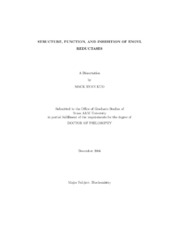| dc.description.abstract | Malaria and tuberculosis constitute two of the world’s deadliest infectious diseases.
Together, they afflict over one third of the world’s population. Once thought of
as one of a group of nearly vanquished diseases only 50 years ago, malaria and tuberculosis
have experienced renewed prominence due to issues such as multi-drug
resistance and a lack of responsiveness by the global community. Fatty acid biosynthesis
has been shown to be an essential pathway to the causative organisms of
malaria and tuberculosis. One integral component of the fatty acid biosynthesis
pathway, enoyl acyl-carrier-protein (ACP) reductase, has repeatedly been validated
as an appropriate drug target in other organisms. The 2.4 Å crystal structure of
the enoyl-ACP reductase from the human parasite Plasmodium falciparum (PfENR)
reveals a nucleotide-binding Rossmann fold, as well as the identity of several active
site residues important for catalysis. The 2.43 Å crystal structure of PfENR bound
with triclosan, a widely utilized anti-bacterial compound, provides new information
concerning key elements of inhibitor binding. Applying knowledge attained from
these initial crystal structures, several triclosan derivatives were synthesized, and
subsequently PfENR:inhibitor co-crystal structures were determined to extend our
knowledge of protein:inhibitor interactions within the active site. Additionally, the
crystal structures of the enoyl-ACP reductase from the mouse parasite Plasmodium
berghei (PbENR), in apo-form and in complex with triclosan, were refined to 2.9 Å and 2.5 Å resolution, respectively. These structures confirm the structural and active
site conservation between the human and mouse parasite enoyl-ACP reductases,
suggesting that utilizing a murine model for in vivo testing of promising inhibitors is
viable. The 2.6 Å crystal structure of the enoyl-ACP reductase from Mycobacterium
tuberculosis (InhA) in complex with triclosan reveals a novel configuration of triclosan
binding, where two molecules of triclosan are accommodated within the InhA active
site. Finally, high-throughput screening approaches using enoyl acyl-carrier-protein
reductases as the targets were utilized to identify new lead compounds for future
generations of drugs. The 2.7 Å crystal structure of InhA bound with Genz-10850
confirms the value of this technique. | en |


